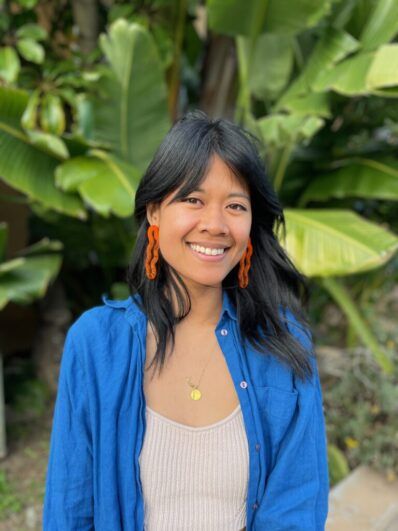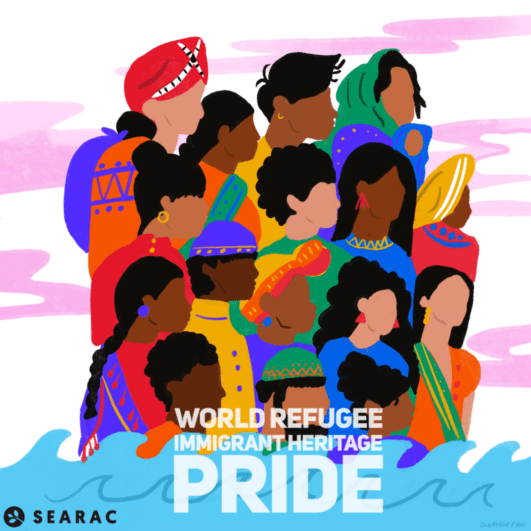interview by Lisa Le

Natalie Bui is a Vietnamese American digital illustrator and movement artist dedicated to centering the narratives and histories of marginalized communities. With a commitment to amplifying and uplifting the political narratives of BIPOP, LGBTIQ+, immigrant, and disabled communities, Natalie’s work is rooted in community care, radical reimagining, and centering joy. She designs and creates digital illustrations for campaigns and organizations that address social justice issues such as abortion rights, immigrant rights, race and gender inclusion, labor rights, civic engagement, and more. We are honored and excited to welcome Natalie as SEARAC’s first ever artist-in-residence. Through her collaboration with us, she will play a vital role in bringing more visibility to the issues impacting Southeast Asian American communities.
How did you end up on this path of being a resident artist?
I’ve been all over the place in terms of my career as an artist. After college, I started working in tech and then transitioned to advocacy spaces and policy work. I moved into labor unionizing work and then I landed at Asian Americans Advancing Justice doing policy work on the advocacy team. One day, I picked up a pen and paper and started illustrating. Then I started illustrating– in particular– Asian American political figures and political narratives that I didn’t see within our own communities or were new to the movement spaces. I didn’t see our Asian American communities reflected in politicized work. And so I started illustrating Asian American political activists and figures and from there have been asked to illustrate Asian Americans across many social justice movements and intersections. It affirmed to me how many people wanted to be seen in this space. I’ve been doing this for 6+ years. A friend recommended that I apply to SEARAC’s artist in residence program and I was excited by the opportunity– so here we are!
Where do you find inspiration? Or, what are your biggest influences?
At the moment, I find inspiration and power within Southeast Asian mythology and specifically Vietnamese folklore, mythology, and creation stories. One Vietnamese creation mythology tells that we are believed to be descendents of dragons and bird fairies. That inspires me and makes me feel so powerful and expansive. It also makes me wonder how can our communities see ourselves in its full expansiveness of what they can be? I also draw inspiration from learning more about our complex goddesses, who are not just about being good or evil, but rather living in the in-between. And it reminds me so much of our abolitionist and social justice movements– reminding us there are no clear binaries; it’s the nuances in between.
I also find inspiration in the little things. I am quick to pick up on how certain colors come together, or I’ll see how a wine bottle is, how strange this flower is, how wild this novel is. Then I go home and recreate it in my own ways. I find it helpful to stay inspired by all the little things.
In terms of what influences my work, I feel moved and inspired by how our movements come together and work in solidarity with one another and how they connect the pieces of our system. I get inspired when I see movements that are rooted in cross solidarity, that center the most impacted, and push the boundaries of building a world of communal care. I love seeing it serve as a model for how other movements can do it. I want to be able to illustrate what communal care means, where the arc of justice is going towards, and what that looks like for our communities.

What types of art and culture do you like to consume?
I really love to read. I have been finding a lot of inspiration from books themselves. Dragon Prince: Stories and Legends fromVietnam sits right on my nightstand and I love books focused on love and fantasy. I enjoy reading romance, and I also love a good horror novel. I recently read this book called How Far The Light Reaches and it talks about the ways nature and the animal kingdom are connected to so many lessons that humans can learn from. I find that I’m consuming a lot of books rooted in curiosity, but also pleasure, joy, and make-believe. It is very much driving where my art is looking to move towards now. In the past, I was reading books on politics, intergenerational trauma, and refugee history to learn more about those dynamics. Now, I’m seeing a big shift in what I’m consuming and what I want to draw from—the magic, the fantasy, the play, the pleasure, and the curiosity. It’s a really big arc, as an artist, of where my journey is headed. It’s also parallel to where I think our social justice movements are moving towards– more pleasure, more play, and more healing.
What process, materials, or techniques do you use to create your artwork?
I am not professionally trained as an artist. I have a degree in Political Science and I picked up a pen and paper 6 or 7 years ago. When I think about the techniques, what I love is that I exclusively use Procreate, my iPad, and an Apple Pencil. I think they make it accessible for new creatives to come and explore art. I hope more people lean into exploring those tools and products because the tools that we grew up with made it seem difficult to get into art, but now it is much easier to take that curiosity and explore with it.
As for my process, I find that it’s a reminder for me to trust my process that continually ebbs and flows. For me, that means taking breaks when I need to, leaning into when the inspiration strikes, and pausing. It also helps me to have a strong central theme or key word. I’m currently working on a series right now for an organization and their ask to me was to draw the world we want to live in. That was incredibly hard for me to envision so I turned to literature from activists– where I can be a student in, and remain curious of.
As an artist, do you feel your work has a responsibility towards the wider context of where you work and live and the world in general?
I think if you had spoken to me a couple years ago, I would have agreed that there’s a huge responsibility to illustrate our communities, our narratives, and our history accurately, ensuring it’s not forgotten. It’s important to understand and remember our generational wounds, our anger, our pain, and how we’ve been marginalized and demand more from that. Now, that has shifted for me. I believe that the arc of social justice work, and for my own purpose, is to be able to work for the sake of creating, healing, and joy. I want to be able to create for the sake of play– and even also for myself. This isn’t often rewarded in our communities. So yes, though I do believe all the work we do is inherently political and there’s a responsibility to remain critical of our systems and institutions, at the same time, I believe our art can serve a purpose just for ourselves. And that in turn affects the communities around us. I’m really curious about our responsibility to create things out of a sense of play— to be able to model and to work from that place of rest and what ripple effect that can create.

What are your hopes and dreams for this residency with SEARAC?
I want to be able to help make movement spaces more accessible. I think this work can feel very intimidating, particularly advocacy and policy work because you have to navigate whole institutions and systems. I have hopes and dreams to make what we are working on more accessible and irresistible. I want people to say, “Oh I want to be a part of that! How can I be a part of that?”
I aim to Illustrate in ways that entice people to want to also build and co-create. I’m having a new relationship with art and movement work and I hope to have space to illustrate what a world looks like solidarity and communal care with each other as opposed to fractional stories.
